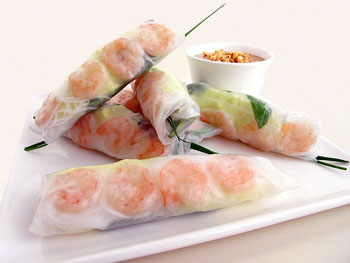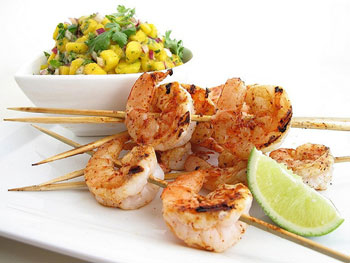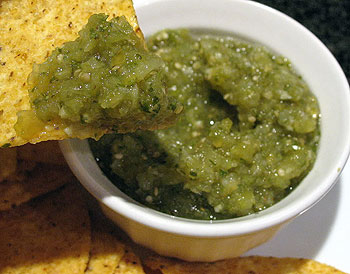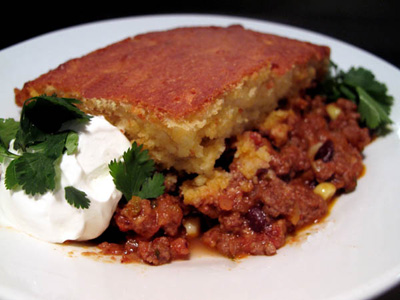 My taste buds have never been so excited as when I'm eating Vietnamese food. I clearly remember my first taste of bánh mì—the baguette sandwich filled with pork, pâté, pickled vegetables, and cilantro—so many year ago. I was struck by the sandwich's refreshing flavor. Since then I've made many Vietnamese recipes. The reason why I love the cuisine so much is because of its wide use of herbs. They bring so much flavor to dishes, but the most flavor comes when they are used fresh.
My taste buds have never been so excited as when I'm eating Vietnamese food. I clearly remember my first taste of bánh mì—the baguette sandwich filled with pork, pâté, pickled vegetables, and cilantro—so many year ago. I was struck by the sandwich's refreshing flavor. Since then I've made many Vietnamese recipes. The reason why I love the cuisine so much is because of its wide use of herbs. They bring so much flavor to dishes, but the most flavor comes when they are used fresh.
This Vietnamese recipe features basil, mint, and chives—all add a burst of flavor to every bite. Unlike fried spring rolls or egg rolls, these fresh summer rolls, also known as spring rolls or salad rolls, contain lettuce and herbs along with rice vermicelli and cooked shrimp. The rolls make a great cold party appetizer. Their fresh taste is the perfect way to celebrate the season.
Global Cuisine
Global Cuisine
My Menudo Recipe
 I don’t want to lose weight, stand in line at the gym, or make short-lived resolutions for 2014 - I resolve to live in the moment.
I don’t want to lose weight, stand in line at the gym, or make short-lived resolutions for 2014 - I resolve to live in the moment.
Days before the holiday I decided that Menudo was my good luck dish for this New Year’s Day. It could have been black-eyed peas or slow cooked green with pot liquor, or lentils with something but I’ve been craving Menudo for months! Menudo is tripe soup with Guajillo chiles, onions, garlic, white hominy and a few other slippery slope ingredients. I planned on freezing 11 little bags of this potion, just in case my luck needs to be topped off…
I thought about creating my Menudo for days. I dragged every cookbook out on the subject and read all about it. I visited with Rick Bayless and Diana Kennedy and that was long overdue. This good luck dish was turning into an adventure. Sure, I could have bought a can of Menudo and left it at that, or flown to Tucson, but instead I drove an hour south in light snow flurries to collect the ‘unusual’ ingredients. I had my grocery list and I was ready for some interaction with the human race after being isolated by bad weather.
Sweet & Spicy Shrimp
 Spicy and tropical flavors always transport my imagination to lush jungles or azure beaches belonging to more temperate climates. Mexican food in particular has that effect on me. At home whenever I want to add a south-of-the-border touch to recipes I reach for dried chiles.
Spicy and tropical flavors always transport my imagination to lush jungles or azure beaches belonging to more temperate climates. Mexican food in particular has that effect on me. At home whenever I want to add a south-of-the-border touch to recipes I reach for dried chiles.
Ancho chile powder, made of ground dried poblano peppers, lends a smoky and earthy flavor to recipes (think of the many famous mole sauces). Combine it with lime juice and oil and you have the perfect Mex-like marinade for meat or fish. In this case it's shrimp, briefly marinated and then grilled. Paired with a fresh salsa, it's a summery dish that serves well as a quick appetizer when friends stop by.
The grilled shrimp is spicy and savory whereas the mango salsa is sweet and tangy. It may sound a bit unusual to have fruit in a salsa, but it's not uncommon in Mexico and the Caribbean. Fruits indigenous to these areas are utilized in many different ways in recipe preparations.
Magic Green Elixir
 Here’s a true confession: Sometimes I really miss the ‘80s. Okay. Maybe I don’t miss the Crystal Carrington hair, the Donna Mills eye shadow, or the chandelier earrings that looked like they should hang over Trump’s dining table. (What are they made of? Foil?? And look! A matching necklace! I could be Queen of QVC!)
Here’s a true confession: Sometimes I really miss the ‘80s. Okay. Maybe I don’t miss the Crystal Carrington hair, the Donna Mills eye shadow, or the chandelier earrings that looked like they should hang over Trump’s dining table. (What are they made of? Foil?? And look! A matching necklace! I could be Queen of QVC!)
But I did have a great time as an anchor and reporter in Dallas in the ’80′s, and do miss the group of girlfriends who joined me after the 5 o’clock news as we ate our way around the Dallas/Ft. Worth Metroplex.
Of all the places we haunted, I think our favorite was Javier’s. Very upscale for Mexican restaurants of that time, it was decidedly old school and elegant in a Mexico City kind of way. There, you wouldn’t find tacos or quesadillas …but rich moles, luscious grilled steaks stuffed with roasted chilies and cheese, and pulled pork that was cooked in a seasoned sauce for so long that it didn’t just melt in your mouth, it melted on your fork on it’s way there.
 But Javier knew, whenever we walked in, that more than the meats or moles, all we really craved was a bucket (or two) of chips and big bowl (or 2) their warm tomatillo sauce. There was no day at work, no traffic so bad or no break-up so fierce, that this sweet yet spicy sauce wouldn’t cure it. It was our Magic Green Elixir.
But Javier knew, whenever we walked in, that more than the meats or moles, all we really craved was a bucket (or two) of chips and big bowl (or 2) their warm tomatillo sauce. There was no day at work, no traffic so bad or no break-up so fierce, that this sweet yet spicy sauce wouldn’t cure it. It was our Magic Green Elixir.
James Moore's Beef Tamale with Cornbread Topping
 This is one of my favorite winter casseroles based on a recipe from The Best Make-Ahead Recipe Cookbook. You can make it in one large 9x13 pan or prepare two 8x8 square pans, and bake one and freeze one for another time. To freeze, wrap casserole in plastic wrap and then cover tightly with foil and freeze for up to 3 months.
This is one of my favorite winter casseroles based on a recipe from The Best Make-Ahead Recipe Cookbook. You can make it in one large 9x13 pan or prepare two 8x8 square pans, and bake one and freeze one for another time. To freeze, wrap casserole in plastic wrap and then cover tightly with foil and freeze for up to 3 months.
To serve, unwrap casserole and let sit at room temperature for 30 minutes, then cover with foil and bake for 30 minutes at 375F. Remove foil and continue to bake about 50-60 minutes longer, until cornbread is golden and filling is bubbly.
It helps to have everything prepped – onions chopped, beans drained, garlic minced, tomato cans opened. Once you begin, the recipe comes together quickly. Don’t start the cornbread until the filling is done and in the pan.
More Articles ...
Welcome to the new One for the Table ...
Our Home Page will be different each time you arrive.
We're sure you'll find something to pique your interest...

